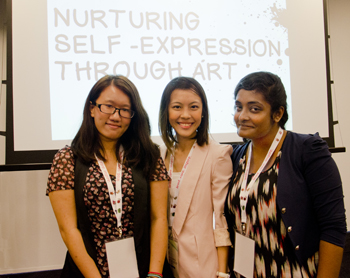Why Singapore’s English Teachers Should Embrace Singlish, Not Fight It
Is it time for Singaporean educators to embrace Singlish as a legitimate learning tool? What the Research […]
Read More
Give pupils enough space in the Art classroom to express themselves freely, and they will grow to enjoy Art. More than just that, they may even discover more about themselves.
Imagine this: A teacher holds up a photo of a cat, and instructs the class to draw it accurately in 2 minutes. How would the pupils feel?
A group of teacher participants at the Teachers’ Conference 2014 were put through this exercise. They later remarked that they felt restricted because they had to reproduce the cat accurately instead of drawing it in their own ways; pressured because of the time limit; and unhappy because they thought their artwork looked “ugly”.
This exercise showed them how creativity killers can affect children’s self-expression and enjoyment when they are learning art.

(From left) Belize Chan Li Chun, Quah Li Zhen and Nurjannah Bte Ayub believe that the Art class can help pupils discover and express themselves.
Self-expression is crucial for the development of pupils’ identity and personhood, and Art as a subject lends itself very well to promoting that.
When pupils feel like they can freely express themselves, they can then begin to explore their interests and strengths. This helps them think about who they are and who they want to grow up to be.
Citing the hierarchy of needs by psychologist Abraham Maslow, Ms Nurjannah Bte Ayub from MacPherson Primary School points out that “if the children don’t feel loved, safe, or that they belong, they will not feel secure enough to express their true inner self.”
There are a few ways teachers can create a nurturing classroom where pupils feel safe expressing themselves without second guessing their artistic choices.
For example, pupils should own the entire creative process. They will have a sense of achievement and gain confidence when they think: “This is my work. Everything is mine, from the thought process to the process of creating it.”
Teachers should also encourage choices in the classroom. For example, they can create learning stations with different choices of medium, such as oil pastels, watercolours or marker pens. The stations could also focus on different art and handicraft skills, such as cutting and sewing.
No matter what approach an Art educator chooses, time management is crucial. Jannah says that some of her lessons span over a few weeks to give pupils enough time to learn, explore, reflect and discuss.
As far as assessment goes, Jannah and Belize do not focus on the grading of the final piece.
However, the pupils themselves may need to be convinced that the final grade is not everything. “They have gone through years of being told that their artwork must be nice and look good,” says Ms Quah Li Zhen of MacPherson Primary School. “So when you tell them to do what they want, the children feel a bit scared to try!”
But she adds: “It takes a while to break away from that feeling of ‘I must draw perfectly and erase away everything else!’ But I find that usually, it only takes a month to break it.”
Teachers can use rubrics that focus on the processes through which pupils acquire artistic behaviour.
“Pupils will excel (in assessment) if they are able to express their thoughts, ideas and feelings,” explains Jannah. “They can also be assessed on how well they reason out why they chose a medium or style.”
Another way is to assess pupils based on their self-awareness and whether they are able to learn from and work with their mistakes. “The idea is to see if they can do it independently or if they need guidance from us on how they should proceed,” Jannah says.
Besides that, pupils can also do self- and peer-assessment by using a checklist to see if they are on track, whether they missed out anything, and how they can do better. The same checklist can be used when they do a “walkabout” in the classroom to check out their peers’ work.
“We hope they will get inspired, and what we notice is that they will usually make changes to their work – not to copy – but because they realize everyone is different, so they can be different too,” says Jannah.
Helping pupils to discover themselves in such a positive manner is what Jannah and her colleagues hope to achieve. “When I was in school, I didn’t like Art because I felt I was never good enough!” she confesses with a laugh. “So I feel their frustration. Ultimately, by encouraging self-expression, we realize our pupils enjoy Art lessons more. And that’s just another reason why we do this.”